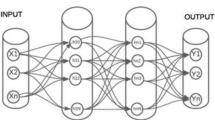Abstract
Software defined network is smart and centralized architecture which increases the network performance and it is efficiently programmed to support different framework of big data and cloud computing virtualization. Several network categorical traffic attacks attributes are many issues which numerous of conventional IDS-Intrusion Detection System with lesser efficiency in terms of recognition, augmented rate of false positive, and bad generalization capacity. Thus, it is necessary to propose a method redresses all of the mentioned issues. In this paper, we propose the IDS methodology to recognize the maliciousness in the Software defined network (SDN) with the novel linearly stable PCA to extract the features. Afterwards, the extracted features will be classified with the novel poly logarithmic function based Naive Bayes classification methodology to diagnose between the normal and abnormal nodes. Finally, we carry out the performance evaluation in terms of accuracy, recall, FPR, TPR, and many performance by using the datasets of \(KDD TEST^{ - 21}\) and KDD TEST plus for validating the proposed IDS performance.









Similar content being viewed by others
Data Availability
Enquiries about data availability should be directed to the authors.
References
Tao, P., Sun, Z., & Sun, Z. (2018). An improved intrusion detection algorithm based on GA and SVM. Ieee Access, 6, 13624–13631.
Liu, H., & Lang, B. (2019). Machine learning and deep learning methods for intrusion detection systems: A survey. Applied Sciences, 9, 4396.
Alrowaily, M., Alenezi, F., & Lu, Z. (2019). Effectiveness of machine learning based intrusion detection systems. In International Conference on Security, Privacy and Anonymity in Computation, Communication and Storage (pp. 277–288). Springer, Cham.
Handa, A., Sharma, A., & Shukla, S. K. (2019). Machine learning in cybersecurity: A review. Wiley Interdisciplinary Reviews: Data Mining and Knowledge Discovery, 9, e1306.
Mishra, P., Varadharajan, V., Tupakula, U., & Pilli, E. S. (2018). A detailed investigation and analysis of using machine learning techniques for intrusion detection. IEEE Communications Surveys & Tutorials, 21, 686–728.
Ahmad, I., Basheri, M., Iqbal, M. J., & Rahim, A. (2018). Performance comparison of support vector machine, random forest, and extreme learning machine for intrusion detection. IEEE Access, 6, 33789–33795.
Alhakami, W., ALharbi, A., Bourouis, S., Alroobaea, R., & Bouguila, N. (2019). Network anomaly intrusion detection using a nonparametric Bayesian approach and feature selection. IEEE Access, 7, 52181–52190.
Ghafir, I., Kyriakopoulos, K. G., Aparicio-Navarro, F. J., Lambotharan, S., Assadhan, B., & Binsalleeh, H. (2018). A basic probability assignment methodology for unsupervised wireless intrusion detection. IEEE Access, 6, 40008–40023.
Lv, S., Wang, J., Yang, Y., & Liu, J. (2018). Intrusion prediction with system-call sequence-to-sequence model. IEEE Access, 6, 71413–71421.
Jan, S. U., Ahmed, S., Shakhov, V., & Koo, I. (2019). Toward a lightweight intrusion detection system for the internet of things. IEEE Access, 7, 42450–42471.
Camacho, J., Therón, R., García-Giménez, J. M., Maciá-Fernández, G., & García-Teodoro, P. (2019). Group-wise principal component analysis for exploratory intrusion detection. IEEE Access, 7, 113081–113093.
Tama, B. A., Comuzzi, M., & Rhee, K.-H. (2019). TSE-IDS: A two-stage classifier ensemble for intelligent anomaly-based intrusion detection system. IEEE Access, 7, 94497–94507.
Prabavathy, S., Sundarakantham, K., & Shalinie, S. M. (2018). Design of cognitive fog computing for intrusion detection in Internet of Things. Journal of Communications and Networks, 20, 291–298.
Narasimha Mallikarjunan, K., Bhuvaneshwaran, A., Sundarakantham, K., & Mercy Shalinie, S. (2019). DDAM: detecting DDoS attacks using machine learning approach. In Computational Intelligence: Theories, Applications and Future Directions-Volume I (pp. 261–273). Springer, Singapore.
Jabbar, M., & Aluvalu, R. (2017). RFAODE: A novel ensemble intrusion detection system. Procedia computer science, 115, 226–234.
Ikram, S. T., & Cherukuri, A. K. (2016). Improving accuracy of intrusion detection model using PCA and optimized SVM. Journal of computing and information technology, 24, 133–148.
Fouladi, R. F., Kayatas, C. E., & Anarim, E. (2016, June). Frequency based DDoS attack detection approach using naive Bayes classification. In 2016 39th International Conference on Telecommunications and Signal Processing (TSP) (pp. 104–107). IEEE.
Serpen, G., & Aghaei, E. (2018). Host-based misuse intrusion detection using PCA feature extraction and kNN classification algorithms. Intelligent Data Analysis, 22, 1101–1114.
Vimalkumar, K., & Radhika, N. (2017, September). A big data framework for intrusion detection in smart grids using apache spark. In 2017 International Conference on Advances in Computing, Communications and Informatics (ICACCI) (pp. 198–204). IEEE.
Kevric, J., Jukic, S., & Subasi, A. (2017). An effective combining classifier approach using tree algorithms for network intrusion detection. Neural Computing and Applications, 28, 1051–1058.
Dhanabal, L., & Shantharajah, S. (2015). A study on NSL-KDD dataset for intrusion detection system based on classification algorithms. International Journal of Advanced Research in Computer and Communication Engineering, 4, 446–452.
Papamartzivanos, D., Mármol, F. G., & Kambourakis, G. (2019). Introducing deep learning self-adaptive misuse network intrusion detection systems. IEEE Access, 7, 13546–13560.
Al-Qatf, M., Lasheng, Y., Al-Habib, M., & Al-Sabahi, K. (2018). Deep learning approach combining sparse autoencoder with SVM for network intrusion detection. IEEE Access, 6, 52843–52856.
Yang, H., & Wang, F. (2019). Wireless network intrusion detection based on improved convolutional neural network. IEEE Access, 7, 64366–64374.
Funding
The authors have not disclosed any funding.
Author information
Authors and Affiliations
Corresponding author
Ethics declarations
Conflict of Interest
The authors declare that they do not have any conflict of interest.
Additional information
Publisher's Note
Springer Nature remains neutral with regard to jurisdictional claims in published maps and institutional affiliations.
Rights and permissions
About this article
Cite this article
Singh, S. Poly Logarithmic Naive Bayes Intrusion Detection System Using Linear Stable PCA Feature Extraction. Wireless Pers Commun 125, 3117–3132 (2022). https://doi.org/10.1007/s11277-022-09701-2
Accepted:
Published:
Issue Date:
DOI: https://doi.org/10.1007/s11277-022-09701-2




